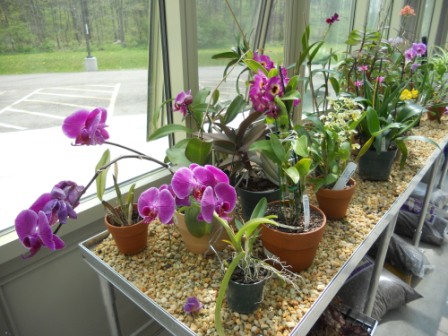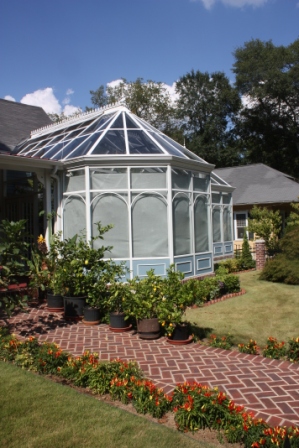
I have found orchids to be an addicting plant. An orchid grower is one of the most passionate and dedicated of all plant growers. After you see an orchid grow, you simply need more of them. At first all of your orchids come from the local grocery store or home improvement businesses. Then you start reading books and look online at growing orchids. It is at this point that you discover there is a whole other world beyond your local grocery store. There are thousands of orchids on the market and you need to find them.
Within a short time you begin taking time off work to go orchid shopping. Your vacations always entail stops at local orchid growers and botanical gardens. When you look at your windowsills there is no space left. A shower rod is hanging in your window with a screen so you can grow hanging baskets in your kitchen. By this point your significant other has had enough of the madness and tells you it is time for a greenhouse! How wonderful it would be to have a greenhouse entirely devoted to orchids.
What is an Orchid Greenhouse
What makes a greenhouse an orchid greenhouse, rather than a generic greenhouse? Simply, it is the orchids that are grown in it. The framing of an orchid greenhouse is the same as that of a palm house or a propagation greenhouse. The interior environment of the greenhouse will be constructed around the environmental needs of the orchids you grow. If you grow cymbidiums and masdevallias, for example, they need a completely different environment than if you are cultivating vandas and psychopsis species. When you have determined the temperature range to be grown, you can turn the attention to your home.
Location, Location, Location

You will need to decide where this orchid greenhouse will be placed and how large it will be. Before even dreaming about an orchid greenhouse, you need to look for southern exposure because it is the best kind of light for orchids. If you do not have southern exposure, east or west will also suffice but you will most likely have less light than a southern location. If you only have northern exposure, your orchids will typically have insufficient light, and will need supplemental grow light.
Another early decision is deciding whether the orchid greenhouse will be attached to your home or be free standing. Both options have benefits and draw backs. A free standing greenhouse will typically supply you with more space than an attached structure and it often adds an architectural element to the home’s property. The greenhouse can be the center of a garden or be tucked away behind a hedge as a private retreat for the gardeners. The downside is that utilities will have to be run further and you will have to battle rain, harsh sun and snow to reach the greenhouse.
An attached greenhouse is the more popular choice for residential greenhouses. You simply exit the living room and step into the orchid greenhouse. It is much easier and more cost effective to run utilities because the greenhouse is touching the existing home. The downside is that you often have a smaller space than a freestanding greenhouse. Depending on the layout of your home the greenhouse may cover light that originally came into the house from a window. With this configuration, you do not have to brave Mother Nature to reach your precious plants.
Make it Ship Shape
The most common shape for a residential orchid greenhouse is a straight eave structure. This means it is attached to the house and where the roof and wall meets it forms a point, not a curve. Older greenhouses from years ago often had a curve, which is still possible, but tends to have a higher cost because the glass has to be bent. A residential greenhouse can also project from the house to a double pitch configuration with a gable end. This adds more space than a lean-to and can often be designed to match the home’s style.
Build a Strong Foundation
After deciding where the orchid greenhouse will be located you need to consider the reality of a foundation. More than likely your orchid greenhouse will be larger than a 6’x 8’ print so it will require a foundation. The most common foundation type is a concrete slab. When talking to a contractor make sure that the slab will be sloped towards a central drain. If your slab is not sloped you will have stagnant water. It is also wise to have a French drain installed around the perimeter of the foundation for additional water drainage.
Interior Design
Inside the greenhouse there are certain elements that are needed to keep the plants flourishing. The bare necessities are heating, cooling, water and ventilation. Throughout the US, the majority of states have cold and hot spells that require supplemental heating and cooling. Each manufacturer has different types of heating options available whether it be a propane heater or a solar panel system. An evaporative cooler is a common way to cool a greenhouse. This is also known as a swamp cooler where water circulates over a sponge and the unit pumps the cooled air into the greenhouse. An evaporative cooler also adds humidity to the air. Some people will decide not to cool the greenhouse and instead empty it over summer by placing all the orchids outside under trees or pergolas. This is a viable option if you have the time to empty the greenhouse in spring and then re-fill it in the fall, as well as having a shaded area on your property.
Don’t Forget the Water
All plants need water to sustain life and your orchids are no exception. A hose hook-up and a sink with a spigot are typically sufficient watering methods. The hose will allow you to quickly water your orchids, while the spigot or faucet lets you place an individual plant underneath it and wash off unwanted pests or dust, sending everything down the drain of your sink. Another option for watering is an automatic misting or drip system. This will take care of the majority of your watering and reduce your time spent watering. An automatic system also allows you to go on vacation and not worry about the orchids being watered by your sister who kills all her houseplants.
Keep the Air Moving
As previously mentioned the greenhouse is a large glass box that will overheat. To this accord you will need ventilation. Hot air rises and becomes trapped in the ridge of the greenhouse. Automatic ridge vents will open and let the hot air escape. On the walls of the greenhouse individual windows or a grouped eave vent can be opened to bring cool air into the greenhouse. Circulation fans placed inside the greenhouse, at opposite corners, keep the air moving. Stagnant air breeds diseases so you will always want your air to move.
Additional Options
A heater, cooling, water and ventilation are all the necessities but there are plenty of other accessories that are great to have, though not imperative. A humidifier is an excellent addition to the greenhouse. Most orchid species love humidity and a humidifier will bring the level of moisture to the air that orchids desire. By having a small machine do the work you do not have to wet the floors and use the hose’s misting setting to add humidity into the air.
The orchids will need somewhere to live, other than on the floor. Benches will need to be added and there are plenty of options on the market. You can buy simple ones at a local hardware store or there are specialty benches that are specifically designed for a greenhouse. A true greenhouse bench will hold more weight than the average bench, allowing you to place your large orchids on a bench. A greenhouse bench is rust and water resistant and will last longer than other benches.
Fixed benches are the most common configuration. The benches are normally 24 – 36” deep and are table height at 30”. There are plastic, metal and wooden framework models available. The plastic and metal will do well in a greenhouse but the wooden ones will most likely rot within a few years. Another possibility is a gravel bench. This bench has a solid top that is filled with water and gravel and as the water evaporates it adds humidity for the orchids. There are tiered benches that allow you to use more of the vertical space for growing. Stanhopeas will find a home in the greenhouse with the addition of a plant hanger which permits you to raise hanging basket species. A plant hanger can be one individual support or a long tube that spans the length of the greenhouse. Potting benches are another useful, practical and desired bench type for the orchid greenhouse. The bench can have any number of items including a sink, faucet, bins for orchid mixes, and shelves for storage and hanging space for tools.
Discuss all the points in this article with the manufacturer. There are numerous manufacturers on the market which are easy to find by doing a simple internet search for “orchid greenhouse”, or “orchid greenhouse for a house.” Review their websites, see jobs they have completed and then decide what will best work for you. All the manufacturers offer different glass options, framing materials and accessory layouts. After researching the companies you will be better educated and more confident in making the final decision for your orchid greenhouse.
Lyndsey Roth is an experienced gardener and greenhouse grower.
Related Articles & Free Email Newsletter
Deciding Between a Lean-To or Attached Greenhouse
The Good and Bad of Glass Greenhouses




Comment here